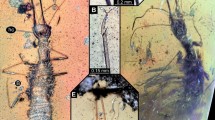Abstract
PRESENT-DAY authorities agree that, within the Mollusca, the chitons (or Polyplacophora) are closely related to the solenogastres (or Aplacophora). An important item influencing this view is the description, by Pruvot1, of the development of seven overlapping, dorsal, plate-like spicules in the metamorphosing larva of the solenogastre, Nematomenia banyulensis. The appearance of these spicules has been considered to be a reminiscence of a chiton-like ancestor and, no doubt, has influenced many authors in coming to the conclusion that the solenogastres are degenerate chitons. Pruvot's description was based on observations on a single larva, but nonetheless the figure he gave of this developmental stage has been widely reproduced in general works.
This is a preview of subscription content, access via your institution
Access options
Subscribe to this journal
Receive 51 print issues and online access
$199.00 per year
only $3.90 per issue
Buy this article
- Purchase on Springer Link
- Instant access to full article PDF
Prices may be subject to local taxes which are calculated during checkout
Similar content being viewed by others
References
Pruvot, G., C.R. Acad. Sci., Paris, 3, 689 (1890).
Baba, K., J. Dept. Agric. Kyusyu Univ., 6, 21 (1938).
Author information
Authors and Affiliations
Rights and permissions
About this article
Cite this article
THOMPSON, T. Development of the Aplacophorous Mollusc Neomenia carinata Tullberg. Nature 184, 122–123 (1959). https://doi.org/10.1038/184122b0
Issue Date:
DOI: https://doi.org/10.1038/184122b0
This article is cited by
Comments
By submitting a comment you agree to abide by our Terms and Community Guidelines. If you find something abusive or that does not comply with our terms or guidelines please flag it as inappropriate.



